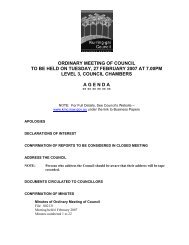Ku-ring-gai Heritage Conservation Areas North Inventory Sheet
Ku-ring-gai Heritage Conservation Areas North Inventory Sheet
Ku-ring-gai Heritage Conservation Areas North Inventory Sheet
Create successful ePaper yourself
Turn your PDF publications into a flip-book with our unique Google optimized e-Paper software.
<strong>Ku</strong>-<strong>ring</strong>-<strong>gai</strong><br />
<strong>Heritage</strong> <strong>Conservation</strong> <strong>Areas</strong> <strong>North</strong> <strong>Inventory</strong> <strong>Sheet</strong><br />
Historical<br />
Summary<br />
the early contact period was Bennelong’s wife Barangaroo, who was noted in colonist’s records for<br />
her strong personality.<br />
Today, there are over 800 culturally significant Aboriginal sites found in <strong>Ku</strong>-<strong>ring</strong>-<strong>gai</strong> National Park,<br />
including rock engravings, rock shelter drawings, paintings and stencils, axe grinding grooves and<br />
shell middens, and Aboriginal people live throughout Sydney metropolitan area.<br />
There are around 100 recorded Aboriginal sites in the <strong>Ku</strong>-<strong>ring</strong>-<strong>gai</strong> LGA and large areas are<br />
considered to have high potential for unrecorded sites. These sites are still important to Aboriginal<br />
people living in the region and there are many Aboriginal people and local residents actively working<br />
to protect these sites and promote the rich Aboriginal heritage of the area.<br />
The earliest European settlement in <strong>Ku</strong>-<strong>ring</strong>-<strong>gai</strong> was along the major roads, and was generally rural<br />
in nature. Du<strong>ring</strong> the 19th century, timber getting and orchards were major activities, and a few villas<br />
were built which are still extant (for example in the 1880s Grandview on Pymble Hill, 1178 Pacific<br />
Highway, the former orange orchard of which now forms part of the grounds of PLC school). Robert<br />
Pymble (commemorated in the suburb name), was an early timber-getter and orchardist who settled<br />
in Pymble in the 1820s and and Robert McIntosh (commemorated in McIntosh Street Gordon) as<br />
another notable early orchardist of <strong>Ku</strong>-<strong>ring</strong>-<strong>gai</strong>.<br />
The <strong>North</strong> Shore Railway line was established in 1890, and subdivision of orchards and large estates<br />
for residential development near the railway stations proceeded thereafter. The location of stations<br />
along the railway defined the focus of the <strong>Ku</strong>-<strong>ring</strong>-<strong>gai</strong> Town Centres and neighbourhood areas (with<br />
the exception of St. Ives, which developed on Mona Vale Road at a later stage). The railway line was<br />
duplicated in 1909, electrified in 1928. The subsequent opening of the Sydney Harbour Bridge in<br />
1932 led to a major shift of Sydney’s elite (the business owners and managers, the doctors,<br />
solicitors, architects, artists, politicians) to the north shore, and particularly <strong>Ku</strong>-<strong>ring</strong>-<strong>gai</strong>, from other<br />
areas of Sydney (particularly Ashfield, Burwood and Strathfield).<br />
Pymble Avenue <strong>Heritage</strong> <strong>Conservation</strong> Area lies within the 1821 60-acre grant to Richard Wall, and<br />
was subdivided in 1894 as the Pymble Station Estate. The lots at this time failed to be developed for<br />
housing, presumably due to the steep terrain and distance from the railway station.<br />
Housing development of the area occurred in the 1920s to 1940s period, and subdivision of the lots<br />
to create battleaxes also began in this period.<br />
By 1943 most lots within the heritage conservation area were developed with housing, including the<br />
battleaxe alotments at Nos. 70 and 72 Pymble Avenue.<br />
Pymble Avenue has wide street verges with blue gum high forest trees, the carriageway is relatively<br />
narrow and features concrete kerbing and gutte<strong>ring</strong> both sides. The street runs north-south and<br />
slopes steeply down from the north. The section within the HCA is slightly curved at its northern end.<br />
The HCA consists of a group of one and two storey houses predominantly from the Inter-war period,<br />
including two heritage items. Neutral buildings within the area are Nos. 45 and 57 Pymble Avenue,<br />
and 70A Pymble Avenue: all other buildings within the HCA are contributory.<br />
Walls are brick or rendered brick, roofs are steeply pitched hipped and/or gabled and finished in<br />
slate or terracotta. Windows are usually timber framed and vertically proportioned. Houses are well<br />
set back from the street within generous garden settings and original front fences are generally low<br />
(under 1.2m in height) and of brick or rendered brick.<br />
The buildings from the key period of significance for the area - Inter war period are predominantly<br />
brick or rendered brick with slate or terracotta tile roofs and timber-framed windows. Traditional front<br />
fencing is generally low brick or rendered brick, and hedging is often a feature.<br />
KU-RING-GAI HERITAGE CONSERVATION AREAS NORTH INVENTORY

















